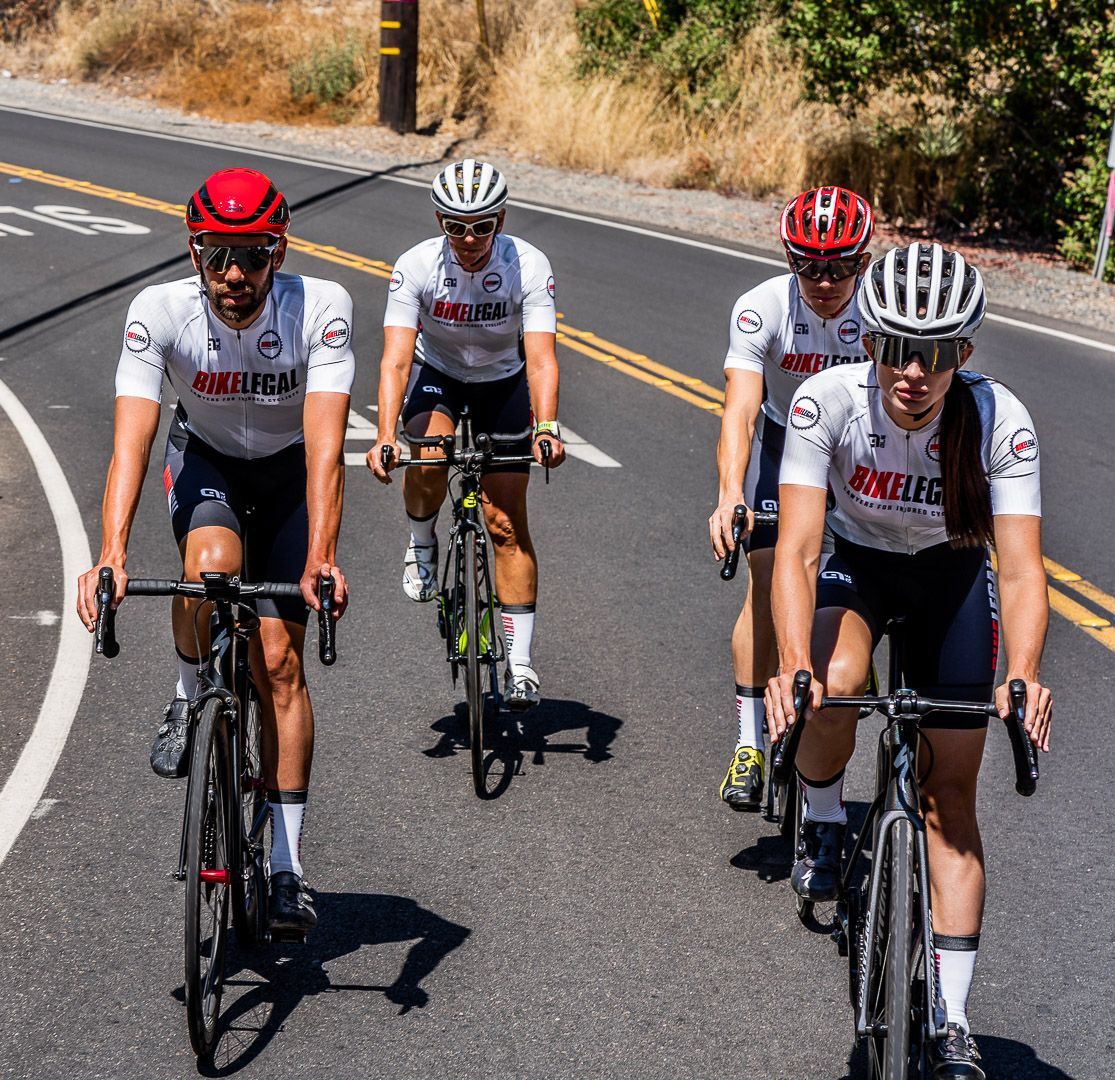Bicycle Light Lumens Guide: How Bright Should Your Lights Be?
Follow us on
social media!
According to the NHTSA, 51% of all bicycle fatalities happen at night or in low-light conditions. Whether you're commuting through city streets or heading home from a training ride, choosing the right bike light brightness can make a life-saving difference.
But how many lumens do you actually need? This guide will cover:
- What are lumens and why do they matter for bicycle lights?
- How bright should front and rear bike lights be?
- Recommended bicycle light lumens for different riding conditions
- Factors that influence your bike light choice
Let’s get started!
What Are Lumens and Why Do They Matter for Bicycle Lights?
Lumens (lm) measure the total visible light emitted by a source. The higher the lumen count, the brighter the light. For bicycle visibility at night, lumen output is crucial for seeing obstacles and being seen by motorists.
Lumens vs. Other Light Measurements
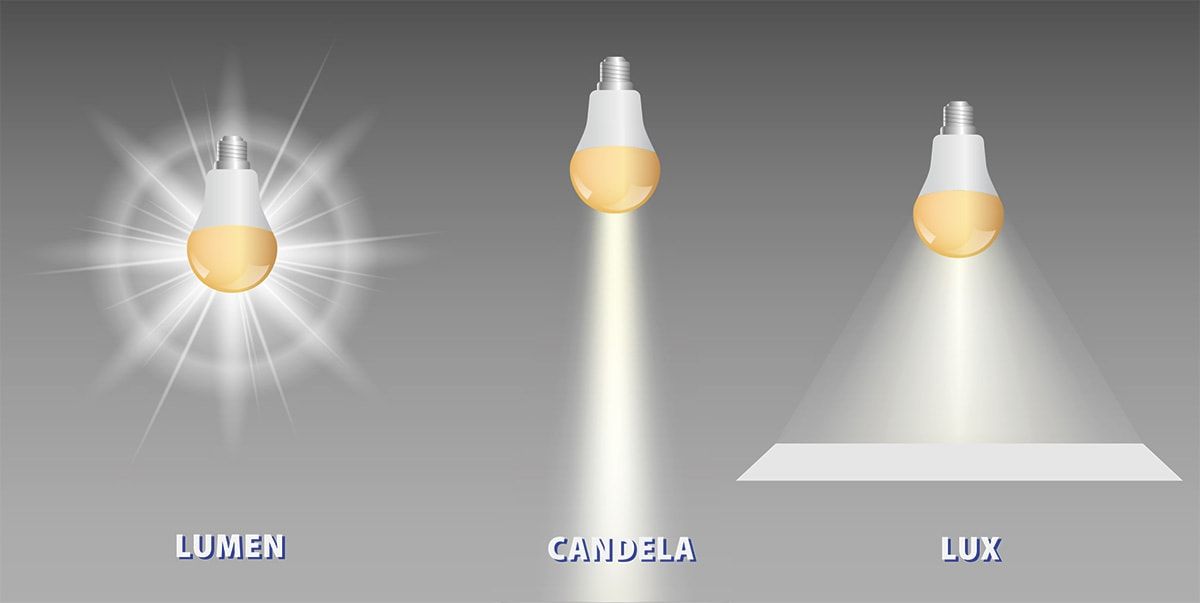
While lumens indicate the total light output, other terms such as lux and candela are used to describe different aspects of light:
- Lux: Measures the amount of light spread over an area.
- Candela: Measures the intensity of light in a specific direction.
How Many Lumens Do You Need for a Bicycle Front Light?
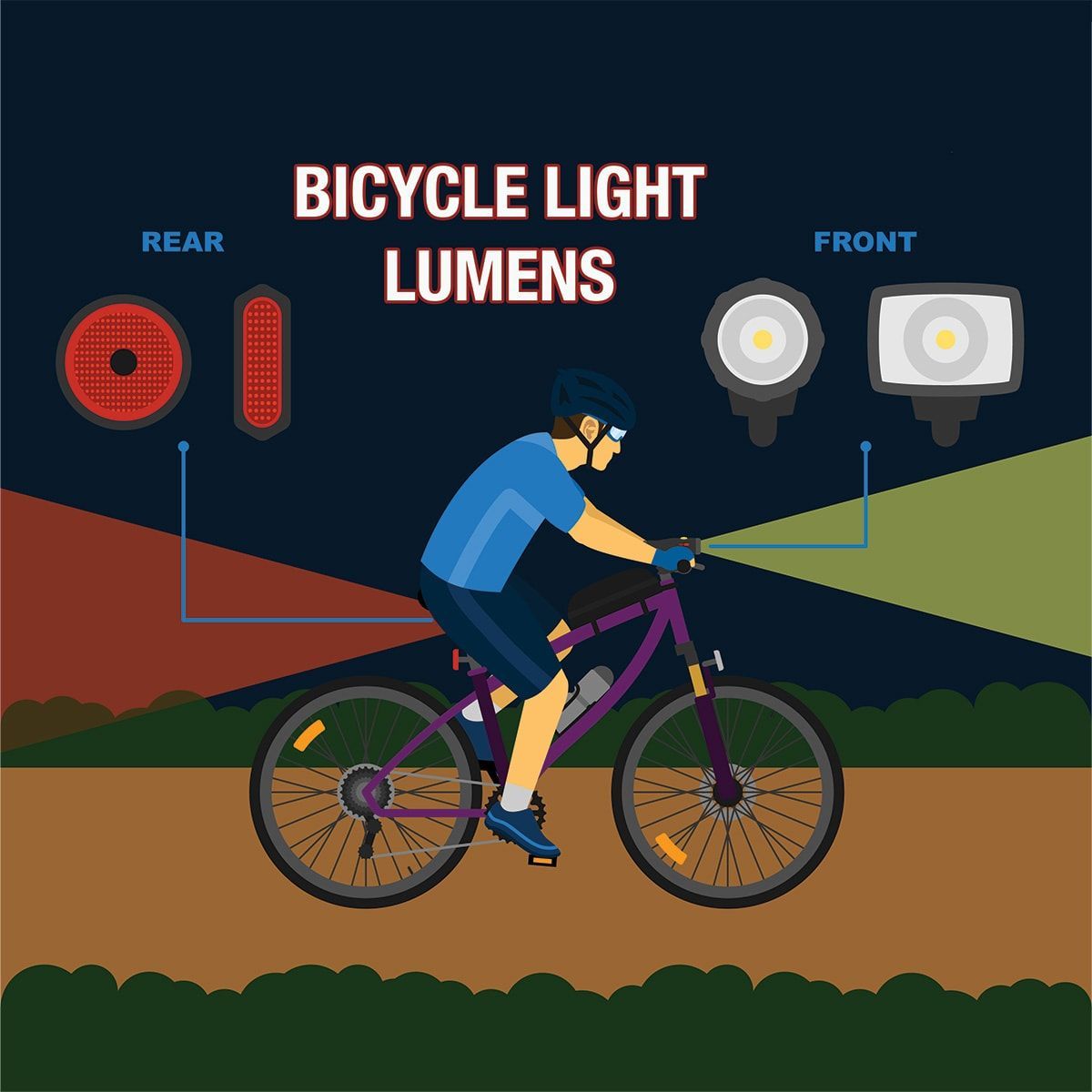
| Riding Condition | Recommended Lumens |
|---|---|
| City / Urban Cycling (Well-lit roads) | 200–500 lumens |
| Suburban / Rural Roads (Minimal lighting) | 500–1000 lumens |
| Trail / Mountain Biking (Complete darkness) | 1000–2000+ lumens |
| High-speed riding (15+ mph) | 700+ lumens |
| Foggy / Rainy Weather | 500+ lumens |
Selecting the right brightness for your bicycle’s front light depends on several factors, including where and how you ride, your speed, and weather conditions.
Here’s a breakdown to help you choose the ideal lumen range:
- Urban riding: In well-lit city environments, a front light primarily serves to illuminate the road ahead. A light with 250–500 lumens is typically sufficient for these conditions. This brightness ensures you are noticeable without overwhelming oncoming pedestrians or drivers.
- Suburban/rural riding: In less populated areas with minimal street lighting, you’ll need brighter lights to illuminate the road and avoid obstacles. Opt for 500–1000 lumens to ensure a safe and well-lit path, especially if the roads are winding or uneven.
- Trail riding: For off-road and trail riding, the light needs to cut through total darkness and highlight every bump, root, or obstacle. A light with 1000–2000 lumens or more is ideal for these adventures, providing ample illumination and a wide beam to navigate tricky terrain confidently.
- Speed considerations: Your riding speed significantly impacts the lumens required for safety. Some general guidelines for lumen count based on speed are:
- Low-speed riders (<15 mph): 200–400 lumens in urban areas, 500–700 lumens in darker settings.
- High-speed riders (15+ mph): 700+ lumens to illuminate farther ahead and ensure enough visibility.
- Weather impact on needed brightness: Poor weather conditions like rain, fog, or snow can reduce visibility, scattering light and diffusing its effectiveness. In these scenarios, consider using a bright front light with 500+ lumens to cut through the weather.
Read More: Check out Can You Ride a Bike in the Rain? for more wet weather riding safety tips.
How Bright Should a Rear Bicycle Light Be?
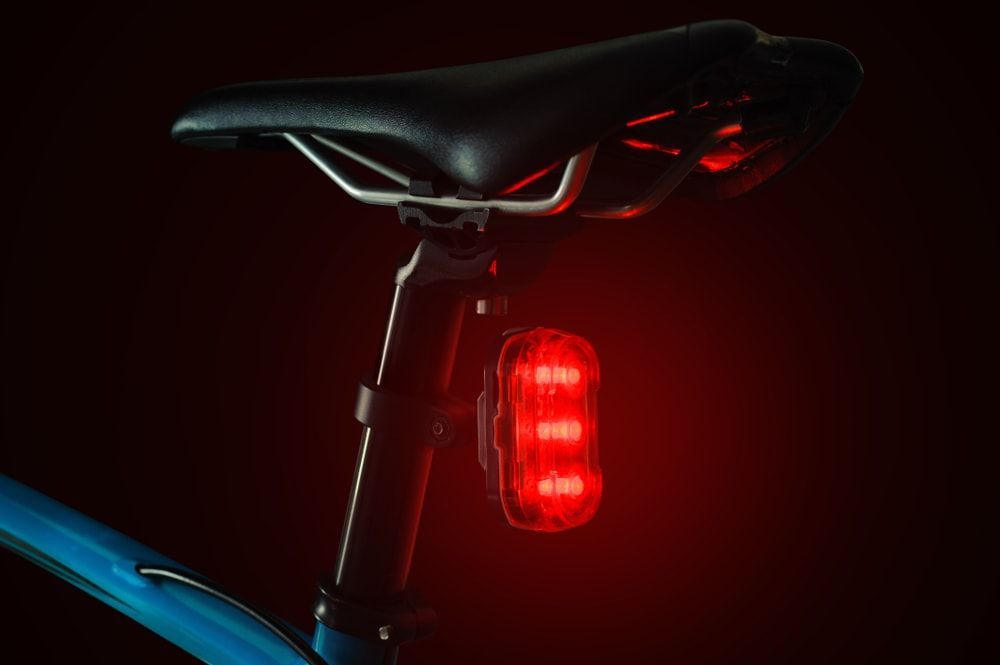
Rear bicycle lights are a critical component of your safety setup. Unlike headlights, which illuminate the road ahead, a bright rear light is designed to make you visible to vehicles approaching from behind.
One of the most common statements from drivers who hit cyclists during the daytime is, "I didn't see them." At Bike Legal, we cannot stress enough the importance of using a bright rear light during the day—not just at night—to increase visibility and reduce the risk of collisions. A strobe or flashing setting is highly recommended for daytime riding, as it significantly increases visibility in bright sunlight.
The brightness requirements for the rear light of your bicycle are listed below:
- Nighttime Recommendations: Rear lights typically range from 30 to 100 lumens. The lower end of this spectrum (30-50 lumens) is sufficient for city riding or areas with street lighting, while more powerful lights (50-100 lumens) are recommended for riding in rural areas or darker environments.
- Daytime Running Lights (DRLs): DRLs are designed to be brighter than standard night-time lights, typically ranging between 100 to 200 lumens. Many rear lights now feature daytime flash modes, specifically engineered to enhance visibility even in bright sunlight. If you ride in traffic-heavy areas or roads with fast-moving vehicles, a high-powered rear light with a flashing setting is crucial for your safety.
Steady vs. Flashing Modes
- Steady Mode: Provides consistent visibility without distraction. It is especially useful for night riding or low-light conditions where a constant, solid light makes it easier for others to gauge your distance and speed.
- Flashing Mode: Highly effective for daytime riding, as intermittent light draws more focus from motorists and pedestrians. Research suggests that flashing lights significantly improve a cyclist’s visibility compared to steady lights in daylight conditions.
Multiple Light Setups
For enhanced safety, consider using multiple rear lights, placed strategically on your bike. This setup increases your visibility from different angles and distances. A common arrangement includes:
- Two steady lights on the sides.
- One flashing light in the center.
Using multiple lights ensures you are seen from all directions, further reducing the risk of a motorist missing your presence on the road.
What Bicycle Light Brightness Do You Need for Different Riding Scenarios?
The ideal bicycle light brightness varies significantly depending on your specific riding conditions, environment, and speed. Understanding these situational requirements will help you choose the appropriate lumen range for your front bike light.
The following is a list of recommended lumens for bike riding at night. Remember, the brighter, the better!
Urban Commuting
- Front Light: 250 to 500 lumens for city riding.
- Rear Light: 100–200 lumens in flashing mode for enhanced daytime safety.
Road Cycling
- Front Light: 400-600 lumens for well-lit roads, 800+ lumens for rural or poorly lit streets.
- Rear Light: 200 lumens in flashing mode to enhance visibility for approaching motorists.
E-Bikes
- Front Light: 500-1000 lumens for higher speeds and longer-range visibility.
- Rear Light: 200-400 lumens in flashing mode for increased visibility.
Mountain Biking
- Front Light: 800 to 1500 lumens for dark trails.
- Rear Light: 200–300 lumens for visibility in rugged terrain.
Gravel Riding
- Front Light: 500-1000 lumens for mixed terrain.
- Rear Light: 150-250 lumens to improve rear visibility on dusty or shadowed trails.
Technical Considerations for Bicycle Lights
When selecting the right bicycle light, it's essential to consider a range of technical factors to ensure maximum safety and performance.
Key factors to consider are:
1. Beam patterns
The beam pattern of your bicycle light determines how the light is distributed on the road. Different types of beam patterns serve specific purposes:
- Wide beam: Ideal for city riding or low-traffic areas, wide beams provide a broad light spread, enhancing visibility without focusing too much on a distant area.
- Narrow beam: Best suited for trail or mountain biking, narrow beams project light further into the distance, helping you see obstacles ahead.
- Combination beams: Many modern bike lights feature a combination of both wide and narrow beams, offering a balance between distance and peripheral coverage. These are excellent for riders who need flexibility on different terrains.
2. Light placement
The position of your bike lights is crucial for safety and performance. Typically, you’ll use two main placements:
| Light Type | Placement | Purpose |
|---|---|---|
| Front Light | Mounted on handlebars or front fork | Optimally illuminates the road ahead |
| Tail Light | Mounted on seat post or rear of bike | Ensures visibility from behind |
3. Battery types and runtime
Today, most bicycle lights are USB-rechargeable, making them convenient for daily use. If you commute to work, you can easily recharge your light while at your desk, ensuring it’s ready for your ride home.
Battery Types:
- Lithium-ion Batteries: The most common and efficient option, offering long battery life and fast charging times. Many high-end bike lights use these for reliability and extended runtime.
- USB-Rechargeable Lights: These are now the standard, allowing you to charge via a laptop, power bank, or wall adapter. A full charge typically lasts between 2 to 20 hours, depending on brightness settings.
- Replaceable Battery Lights (AA/AAA): Less common but still available, these lights require frequent battery swaps and often have shorter runtimes.
Runtime Considerations:
- Lower brightness settings (200-500 lumens) can last 8-20 hours on a single charge.
- Medium brightness settings (500-1000 lumens) generally last 4-8 hours.
- High brightness settings (1000+ lumens) often provide 1.5-4 hours of runtime, making it essential to plan for charging.
- Flashing modes significantly extend battery life compared to steady modes.
To avoid running out of power mid-ride, look for lights with battery level indicators and consider carrying a power bank for longer rides. Many modern lights also feature automatic dimming or low-power modes to conserve battery life when running low.
4. Waterproofing standards
Since cycling often involves exposure to weather elements, waterproofing is an essential feature. The Ingress Protection (IP) rating indicates the level of waterproofing:
| IP Rating | Description |
|---|---|
| IPX4 | Can withstand splashing from any direction, suitable for occasional rain. |
| IPX6 | Provides protection against powerful jets of water, offering reliable protection during heavy rain. |
| IPX7 | Offers protection against immersion in water up to 1 meter, ensuring your light stays operational even in deeper puddles or brief submersions. |
5. Mounting options
The mounting system of a bike light is critical for stability and ease of use. Depending on the light design, you may find different mounting options, including:
- Handlebar mounting: Most front lights are designed to fit on handlebars. Look for a mount that offers secure attachment and simple adjustments and is compatible with different handlebar sizes.
- Helmet mounting: For mountain bikers who prefer more focused lighting, helmet mounts allow for more directional control of the light, enabling better visibility in tight or technical spots.
- Seat post/rear mounting: For rear lights, seat post mounts are most common. Ensure the mount securely holds the light in place, even over bumpy terrain.
Legal & Regulatory Requirements for Bicycle Light Lumen across various states
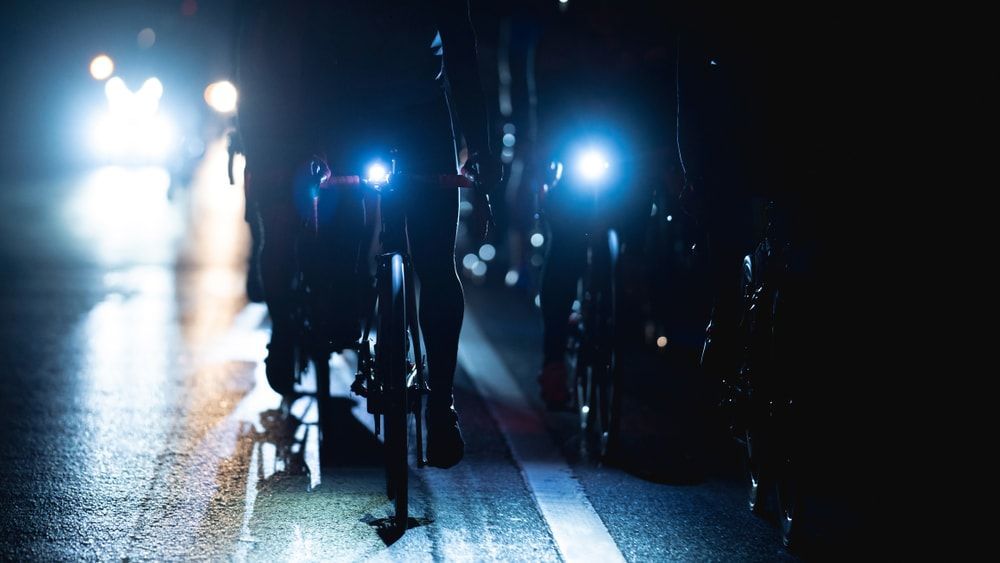
When it comes to bicycle lighting, understanding the legal and regulatory requirements for lumens is crucial for ensuring both safety and compliance. Different states have varying laws that dictate the minimum lumen output for front and rear bicycle lights, particularly when riding in low-light conditions or at night.
Below is an overview of the lighting laws for various states:
1. New York
Per the New York State DOT, bicycles must be equipped with the following lighting from half an hour after sunset to half an hour before sunrise: a front white light visible from at least 500 feet ahead, and a rear red or amber light visible from at least 300 feet behind.
Additionally, one of these lights must also be visible from at least 200 feet on each side of the bicycle, ensuring maximum visibility for both the rider and other road users.
2. California
California Vehicle Code 21201, requires your bicycle to be equipped with a white light visible from 300 feet ahead and on the sides. Alternatively, the light can be attached to the rider, such as on a helmet, as long as it's still visible from 300 feet.
Additionally, a red reflector or a solid or flashing red rear light with a built-in reflector must be mounted on the rear of the bike, visible from 500 feet when illuminated by a motor vehicle’s headlights.
3. Oregon
Oregon Bicycle law requires bicycles to have proper lighting for low visibility conditions, such as at night. The front must have a white light visible from at least 500 feet, while the rear requires a red light or reflector visible from at least 600 feet.
4. Nevada
Nevada Rules of the Road requires Bicycles ridden at night or in low visibility must be equipped with specific lighting and reflectors.
The front of the bike must have a white light visible from at least 500 feet, while the rear should feature a red reflector visible from 50 to 300 feet when illuminated by a vehicle's low beams. These requirements are designed to enhance the cyclist's visibility and safety on the road.
5. Utah
Utah Vehicle Code 41-6a-1114 states that bicycles must be equipped with specific lights and reflectors. The front must have a white headlight visible from at least 500 feet, while the rear requires a red taillight or reflector visible from at least 500 feet.
Most other states follow similar lighting requirements, with slight variations in visibility distances and additional reflectors or safety gear. It is important to consult your local regulations to confirm specific lighting rules in your state.
Factors to Consider Before Choosing the Right Bicycle Light: A Buyer’s Guide
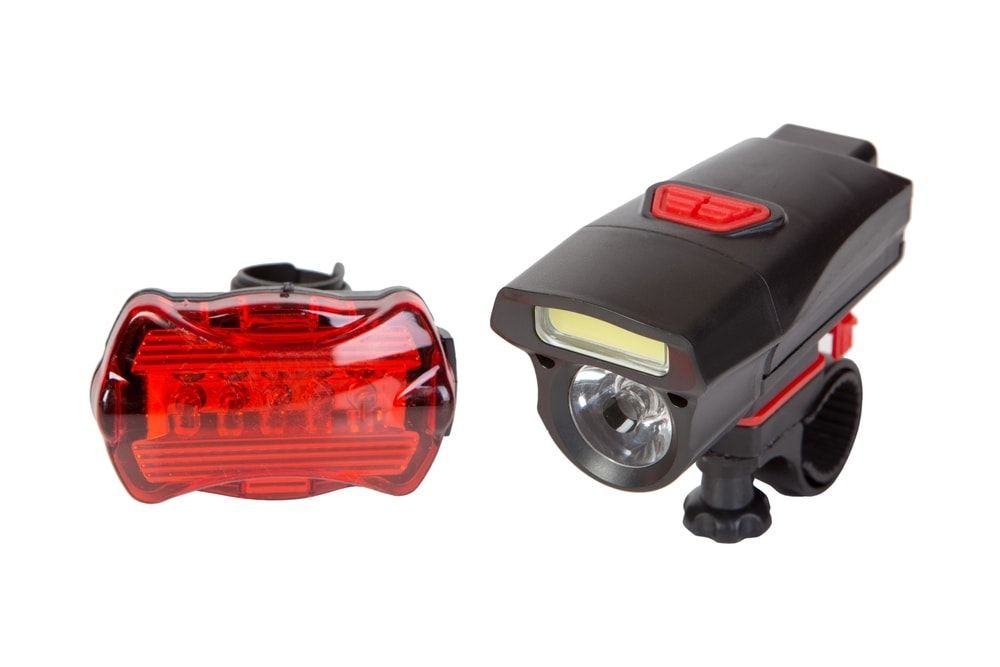
Choosing the best bicycle lights involves more than just selecting the brightest option available. Here are some key factors to consider to ensure you get the best bike light for your needs:
1. Weight & size
The weight and size of your bike light should align with your type of cycling. For urban commuters, a compact, lightweight light is ideal. It won't add unnecessary bulk or interfere with handling while zipping through traffic.
On the other hand, mountain bikers or those riding on rural roads might benefit from larger, more powerful lights that offer higher lumen output and better visibility in off-road or dark trail conditions.
Keep in mind, a smaller light won't provide as much power but is more maneuverable for city cycling.
2. Pricing
Bicycle lights range widely in price, from budget options to high-end models with advanced features. While affordability is a factor, prioritize brightness, durability, and battery life—key components that impact your safety.
For example, a $20 light might be sufficient for short city commutes, but for night riders or adventurous cyclists, investing in a more expensive, high-quality light could mean better visibility and longer-lasting performance, making it worth the extra cost.
3. Durability
Durability is crucial for any cyclist, especially if you're regularly out in rough weather or tough terrain. Road cyclists traveling through rain need lights made from water-resistant materials, while mountain bikers should opt for lights constructed from impact-resistant materials like aluminum or high-strength plastic.
4. Ease of charging
Charging convenience is key, especially for cyclists who rely on their lights daily. USB-rechargeable lights are perfect for those who want to charge from any source—whether it’s a power bank, laptop, or wall adapter.
For long-distance riders, look for lights with fast-charging capabilities and long battery life to ensure you’re never caught in the dark mid-ride. Lights with battery life indicators are also helpful, as they let you know when it’s time to recharge.
Maximizing Visibility: A Simple Habit That Saves Lives
The right bicycle light setup is essential for staying safe, whether you’re riding at night or during the day. Don’t just think about visibility in low-light conditions—daytime riding requires a bright rear tail light as well.
Key Takeaways:
- Always use a bright rear tail light on every ride. A flashing 100-200 lumen rear light during the day can be the difference between a driver seeing you in time or not.
- Higher lumens mean greater visibility. Urban riders may need 250-800 lumens for front lights, while off-road cyclists require 800-1500 lumens or more.
- Match your light to your riding environment. A wide beam is best for city streets, while a focused beam helps illuminate obstacles on trails.
- Flashing lights increase attention. Using a rear light in flashing mode makes you more noticeable to drivers, especially in bright daylight.
Make it a habit to turn on your rear light before every ride. It’s a simple step, but it could be the one that ensures a driver sees you at that critical moment. Don’t leave your safety to chance—light up and stay seen!
Frequently Asked Questions (FAQs)
1. How bright should bicycle lights be?
The brightness of your bicycle lights depends on where and when you ride. For urban cycling, 200-500 lumens for the front light is generally sufficient. For rural roads and off-road trails, you may need 800-1500 lumens. A rear light of 100-200 lumens in flashing mode is highly recommended for both day and night riding.
2. Is 500 lumens bright enough for cycling?
Yes, 500 lumens is generally bright enough for city commuting and well-lit roads. However, for darker rural roads or trails, you should consider 800 lumens or more to ensure better visibility. Pairing your front light with a flashing rear light of at least 100 lumens can significantly enhance your safety.
3. Should a bike tail light flash or be steady?
For nighttime riding, a steady rear light helps drivers gauge your distance. During the day, a flashing tail light is far more effective in catching motorists' attention. Many cyclists use both modes depending on the conditions, but a flashing rear light is crucial for daytime visibility.
Ride Protected. Ride Safe, with Bike Legal

At Bike Legal, we’re more than just personal injury lawyers—we’re passionate cyclists advocating for injured cyclists. If you or someone you know has been involved in a bicycle accident, we’re here to fight for your rights and get you the compensation you deserve.
With a deep love for cycling and unparalleled legal expertise, we understand the unique challenges cyclists face. Our Bike Legal team works tirelessly to ensure you get the highest compensation for your injuries and damages, combining our personal cycling experience with professional legal skills.
Reach out to Bike Legal for a Free Consultation by calling 877-BIKE LEGAL (877-245-3534) or submitting a form. Experience the difference of having a team of cyclists fighting for your rights.
Read More:

